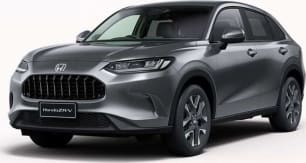The Pathfinder is a thoughtfully packaged and practical vehicle, trading on more than just size with plenty of clever storage solutions.
In the front there are generous door bins, twin cupholders and a deep central cubby. But there’s more, with a thin rubberised storage shelf above the glove box perfect for phones or sunglasses and a pass-through space below the centre console for larger items.
A storage space for a smartphone is found in close proximity to USB-A, a USC-C and 12-volt sockets. All of thus is beneath a physical switch panel for the dual-zone climate control.
The 9.0-inch multimedia touchscreen is the only letdown, feeling quite small in the Pathfinder's vast cabin. It is still responsive and features wireless Apple CarPlay and Android Auto, though. The Pathfinder’s sound system is passable after tweaking the bass and treble balance.
The analogue speedometer and tachometer sits either side of a 7.0-inch media screen that gives driving information along with settings for safety systems. There are switches on the steering wheel to control major functions, including cruise control, media and the screen operation.
Among its competitive set, the US-built Pathfinder’s build quality is excellent. There are cleverly positioned soft-touch plastics and we didn’t notice any rattles over our week of testing, unlike Palisades and Klugers. The steering wheel, especially, is appointed in a high quality, smooth-grained leather.
While the ST-L may only get cloth upholstery, which is admittedly harder to clean than leather, the high-quality material is more temperature stable than the imitation cow hide often seen at this price. It’s also combined with heated front seats.
Adding to the comfort factor is power adjustment for the driver’s seat including in/out and up/down lumbar control. The passenger seat is manually adjustable but with a lever for height and the driving position is pleasingly low-set.
The low front seats open up a world of excellence for the second row’s stadium seating which gives passengers a fantastic view out. Not only is this just nice, it also helps kill travel sickness for kids (and grown-ups).
The second row is on front/back sliding rails with fine backrest adjustment to dial in a comfortable position. There’s ample room even for adults over 185cm with plenty of head, leg and toe-room.
Amenities include a third climate zone, USB-A and USB-C charge points, a total of six beverage holders and a fold-out armrest.
The Nissan Pathfinder has ISOFIX tabs in the two outboard rear seat positions. The anchors are not hidden behind a cover so there is nothing to lose and the three top tether points are big and meaty for easy access.
Nissan deserves praise for its wide opening doors, the Pathfinder’s go almost perpendicular to the body with a large square aperture making loading dogs, children or shopping extremely easy.
But there’s one crucial flaw — the back windows don’t go all the way down leaving around a third of the glass sticking up.
The Pathfinder’s three-wide third row is vast in the third row, with enough space for adults in a pinch — at least two across the three-wide bench — and up to four beverages.
The power-actuated second row gets out of the way quickly (perhaps a little too fast!) and slides back into place easily. The rear bench is split 60/40 with the long portion on the Australian kerbside.
There are no ISOFIX or top tether points in the third row of the Pathfinder ST-L which does hurt its practicality. The Ti-L features ISOFIX and top tether for one third row seat.
Aside from that, the Pathfinder is about as good as an SUV gets for practicality, though a Kia Carnival people mover has the edge for outright human carrying ability.
Behind the shapely power tailgate, the Pathfinder offers either 205L, 554L or 782L of cargo space depending on how many seats are in use. And while the smallest figure sounds compact, the space is tall and square making it quite practical. Four school bags would fit easily or five at a pinch.
With the third row stored elegantly in the floor, the space is generous although interrupted by the roof-mounted middle third-row seat belt which is a faff to unbuckle.
Amenities include two shopping bag hooks, a 12-volt socket, four tie-down points and a spacious wet storage area below the boot floor.
The spare tyre is hung beneath the Pathfinder however it is a temporary space saver, rather than a full-size item.
Despite no diesel powerplant, the Pathfinder’s towing capacity is best in class, beating both Palisade and Kluger with its 2700kg braked limit (750kg unbraked).
Though still shy of the ladder frame Ford Everest and Isuzu MU-X (3500kg), the monocoque Pathfinder’s high limit is impressive.








.png)




































.png)



























